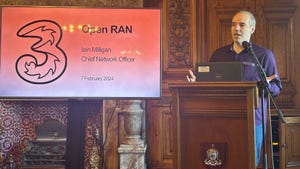
Europe's biggest network equipment makers said they have taken steps to diversify their supply chains following reports that US authorities may force them to build gear for the US market outside of China amid trade conflict between the two economic superpowers.
Both Nordic vendors use facilities in China to make and assemble equipment for the US 5G market and could be forced to look for alternatives under new rules being considered by the Trump administration, according to a report from the Wall Street Journal.
As part of a 150-day review of the US telecom supply chain, US officials are said to be in discussion with equipment makers about the feasibility of developing hardware and software outside of the Chinese market.
Ericsson was not prepared to comment on ongoing discussions with the US government but said it has already tried to mitigate the type of supply chain risks that a US ban on Chinese production would create.
"As for any company operating on a global market, our production strategy must meet the needs of all our customers across the world and we aim to produce close to our customers," said an Ericsson spokesperson in emailed comments. "Our supply chain is flexible with production capabilities in countries on all continents, including the US, Brazil, Estonia, India and China.
"We actively mitigate different types of potential risks related to our supply chain, both in our own manufacturing and in sourcing, to avoid being dependent on one supply site or vendor," the company added.
On the software side, Ericsson said all its products are "verified, signed and distributed centrally from Sweden, and, when so required, under Swedish export licenses."
Nokia responded along similar lines, saying it "has a global manufacturing footprint designed for optimized global supply, and to mitigate against risks such as local disruptive events, transportation capacity and political risks" in a statement emailed to Light Reading.
Want to know more about 5G? Check out our dedicated 5G content channel here on
Light Reading.
The WSJ report appears in the middle of a trade war between the US and China and comes weeks after US authorities added Huawei, a Chinese rival of Ericsson and Nokia, to an "Entity List" of companies that cannot do business with US organizations unless a special license has been issued. The Trump administration has accused Huawei of violating intellectual property and selling telecom equipment to Iran in breach of US sanctions. Arguing it has close links to China's government, they also say its products may include technology that allows Chinese authorities to spy on other countries.
Huawei denies those charges and has called for tougher security checks on all vendors, pointing out that supply chains in the telecom market are increasingly global in nature and that Nokia Shanghai Bell -- a business Nokia inherited (and subsequently rebranded) with its 2016 takeover of Alcatel-Lucent -- is part owned by the Chinese state.
While that is unlikely to deflect US attention away from Huawei, US authorities may have listened to arguments that Ericsson and Nokia are heavily reliant on China as a manufacturing hub and could, therefore, pose a similar security risk to Huawei.
A potential concern is that Chinese authorities try introducing spyware into network components during the manufacturing or assembly process.
But Nokia insists all products undergo checks at its Finnish headquarters. "Regardless of geographical location where Nokia's products and services are manufactured or made, the same criteria are applied to ensure security and integrity, and a central team at our international headquarters verifies security status and compliance," it said. "Earlier this month, we further strengthened our commitment to network security by unveiling an enhanced security program and establishing an advanced security testing and verification laboratory at Nokia Bell Labs in Murray Hill, NJ."
Although Ericsson and Nokia have downplayed the impact of US government moves, the development of alternative supply chains could drive up costs and restrict choice for both vendors.
According to Citi analysts cited in the WSJ story, China represented about 45% of Ericsson's "manufacturing-facility area" last year, and 10% of Nokia's. Ericsson, they say, was operating at roughly 75% capacity in 2018, implying it has flexibility to shift production elsewhere.
Last August, the Swedish company announced plans to hire hundreds of new staff in the US dedicated to 5G radio access and AI developments. It also said it would begin manufacturing 5G products in the US in partnership with a local partner called Jabil, with headquarters in Florida.
Both European vendors have become reliant on US business for sales growth as other markets continue to show signs of weakness. In the first quarter, Nokia's sales were up 9% in North America but just 2% globally, compared with the year-earlier period. Ericsson managed a 43% increase in North American revenues, thanks to a surge in 5G-related business, compared with a 13% rise in total sales.
Related posts:
— Iain Morris, International Editor, Light Reading
About the Author(s)
You May Also Like












